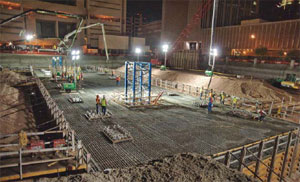
“Phasing the project allowed us to start construction over a year earlier,” McMillen says. Excavation work, utility relocation, foundation work and even steel went up before the final plans were delivered last month.
The existing Madison Street Parking Garage and 1st Avenue Jail were demolished earlier this year, and in July, crews with Phoenix-based Suntec Concrete completed a 10-hour pour totaling 5,200 cu ydsof concrete for the 7-ft-deep, 66-ft-wide and 240-ft-long mat foundation.
McMillen adds that phasing allows the pre-purchasing and early manufacture of components and gives contractors the ability to get a jump on subcontractor contracts.
“This is truly an integrated project delivery method,” McMillen says. At the peak of construction, 900 to 1,000 workers will be on site.
Gilbane/Ryan set up a construction waste management plan from the very beginning, says Alex Tsuji, the project’s green building consultant with Phoenix-based Green Ideas. This helped the team divert over 90% of demolition debris from landfills. At least 10% of building materials used will have recycled content and 10% will be locally sourced.
Because of the function of the building, sustainable practices sometimes took a back seat to safety, circulation and courtroom acoustics. “Because of that we had to focus on the elements of sustainability that were appropriate, such as the mechanical-based systems,” Tsuji says. The tower includes a complex network of HVAC zones.
The project connects to Northwind Phoenix which provides shared chilled water to dozens of downtown Phoenix buildings and should help the building achieve an overall 12% energy reduction.
Tsuji says it has been interesting to see how the USGBC perceives the district cooling system. “Bottom line is connecting to a thermal loop is better in terms of the environmental benefits and overall energy use, but from the USGBC’s perspective, they require you to include the Northwind loop as part of the energy analysis.”
Evans says the building’s “inspiration is rooted in Arizona,” with copper accents and precast concrete colored like the old courthouse. The court tower will connect to the East and Central court buildings.
The project will eventually house 32 courtrooms, but ten of those will be shelled for future completion.
Key Players
Owner: Maricopa County
Architect: Gould Evans; AECOM
General Contractor: Gilbane/Ryan
Engineers: Syska Hennessy Group; Paragon Structural Design; PK Kland
LEED Consultant: Green Ideas
Commissioning: Enovity, Inc.
Subcontractors: Buesing Corp.; Dickens Quality Demolition; Schuff Steel; Suntec Concrete; Rosendin Electric; University Mechanical
Useful Sources


Post a comment to this article
Report Abusive Comment